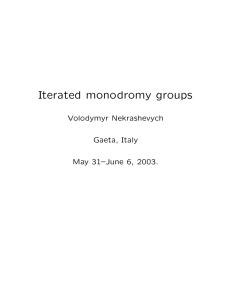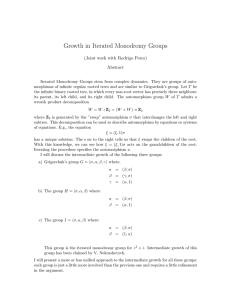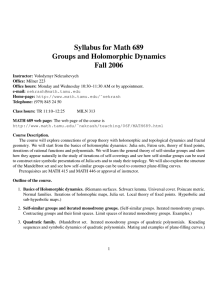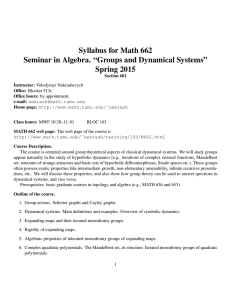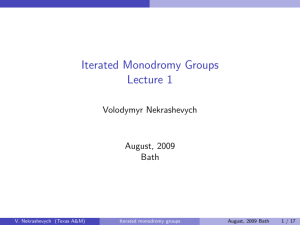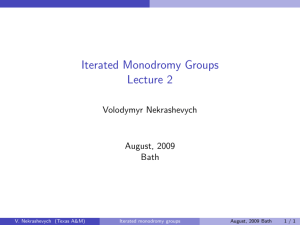7. Limit dynamical systems of contracting groups
advertisement
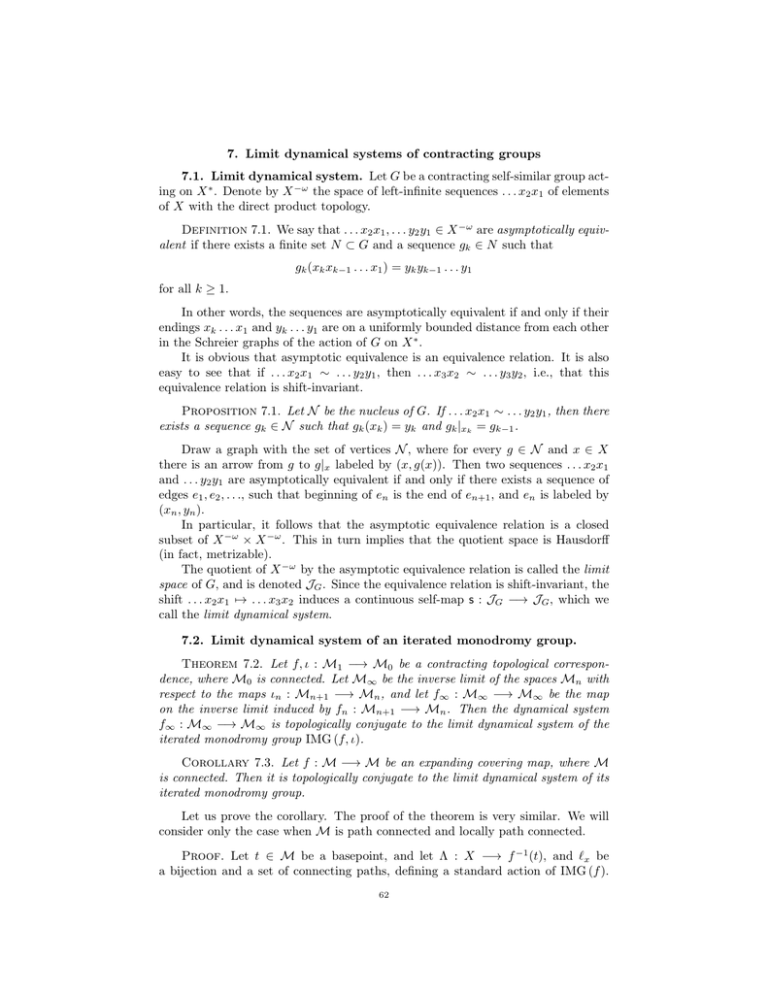
7. Limit dynamical systems of contracting groups
7.1. Limit dynamical system. Let G be a contracting self-similar group acting on X ∗ . Denote by X −ω the space of left-infinite sequences . . . x2 x1 of elements
of X with the direct product topology.
Definition 7.1. We say that . . . x2 x1 , . . . y2 y1 ∈ X −ω are asymptotically equivalent if there exists a finite set N ⊂ G and a sequence gk ∈ N such that
gk (xk xk−1 . . . x1 ) = yk yk−1 . . . y1
for all k ≥ 1.
In other words, the sequences are asymptotically equivalent if and only if their
endings xk . . . x1 and yk . . . y1 are on a uniformly bounded distance from each other
in the Schreier graphs of the action of G on X ∗ .
It is obvious that asymptotic equivalence is an equivalence relation. It is also
easy to see that if . . . x2 x1 ∼ . . . y2 y1 , then . . . x3 x2 ∼ . . . y3 y2 , i.e., that this
equivalence relation is shift-invariant.
Proposition 7.1. Let N be the nucleus of G. If . . . x2 x1 ∼ . . . y2 y1 , then there
exists a sequence gk ∈ N such that gk (xk ) = yk and gk |xk = gk−1 .
Draw a graph with the set of vertices N , where for every g ∈ N and x ∈ X
there is an arrow from g to g|x labeled by (x, g(x)). Then two sequences . . . x2 x1
and . . . y2 y1 are asymptotically equivalent if and only if there exists a sequence of
edges e1 , e2 , . . ., such that beginning of en is the end of en+1 , and en is labeled by
(xn , yn ).
In particular, it follows that the asymptotic equivalence relation is a closed
subset of X −ω × X −ω . This in turn implies that the quotient space is Hausdorff
(in fact, metrizable).
The quotient of X −ω by the asymptotic equivalence relation is called the limit
space of G, and is denoted JG . Since the equivalence relation is shift-invariant, the
shift . . . x2 x1 7→ . . . x3 x2 induces a continuous self-map s : JG −→ JG , which we
call the limit dynamical system.
7.2. Limit dynamical system of an iterated monodromy group.
Theorem 7.2. Let f, ι : M1 −→ M0 be a contracting topological correspondence, where M0 is connected. Let M∞ be the inverse limit of the spaces Mn with
respect to the maps ιn : Mn+1 −→ Mn , and let f∞ : M∞ −→ M∞ be the map
on the inverse limit induced by fn : Mn+1 −→ Mn . Then the dynamical system
f∞ : M∞ −→ M∞ is topologically conjugate to the limit dynamical system of the
iterated monodromy group IMG (f, ι).
Corollary 7.3. Let f : M −→ M be an expanding covering map, where M
is connected. Then it is topologically conjugate to the limit dynamical system of its
iterated monodromy group.
Let us prove the corollary. The proof of the theorem is very similar. We will
consider only the case when M is path connected and locally path connected.
Proof. Let t ∈ M be a basepoint, and let Λ : X −→ f −1 (t), and `x be
a bijection and a set of connecting paths, defining a standard action of IMG (f ).
62
7. LIMIT DYNAMICAL SYSTEMS OF CONTRACTING GROUPS
63
There exist constants C > 0 and ρ ∈ (0, 1) such that for every x ∈ X every lift of
`x by f n is of diameter less than Cρn , see the proof of Proposition 6.12.
Let . . . x2 x1 x0 ∈ X −ω . Let `(0) = `x0 , and define `(n) as the lift of `xn by
−n
f
starting in the end of `(n−1) . Then `(n) `(n−1) . . . `(0) is a path from t to
Λ(xn xn−1 . . . x0 ), see the definition of Λ in 5.7.
Since diameter of `(n) is less than Cρn , the sequence Λ(xn xn−1 . . . x0 ) is Cauchy.
Denote its limit by Λ(. . . x2 x1 x0 ), and denote by `...x2 x1 x0 the path . . . `(2) `(1) `(0) .
Suppose that . . . x2 x1 x0 and . . . y2 y1 y0 are asymptotically equivalent. Let gn ∈
N be a sequence such that gn (xn . . . x0 ) = yn . . . y0 for all n. There exists K > 0
such that diameter of any lift of any g ∈ N (as a loop based at t) by f n is less than
Kρn . Then gn (xn . . . x0 ) = yn . . . y0 means that there exists a lift of gn by f n+1
starting in Λ(xn . . . x0 ) and ending in Λ(yn . . . y0 ). Consequently, the distance from
Λ(xn . . . x0 ) to Λ(yn . . . y0 ) is less than Kρn . Consequently, the limits Λ(. . . x1 x0 )
and Λ(. . . y1 y0 ) coincide.
On the other hand, if Λ(. . . x1 x0 ) = Λ(. . . y1 y0 ), then the loops gn = `−1
...yn+2 yn+1 `...xn+2 xn+1
satisfy gn (xn ) = yn and gn |xn = gn−1 . Using Lemma 6.14 we can show that the set
{gn } ⊂ IMG (f ) is finite. Consequently, . . . x1 x0 and . . . y1 y0 are asymptotically
equivalent.
We have shown that the map Λ induces a well defined injective map Λ : JG −→
M.
Its continuity easily follows from the exponentially decreasing estimates on the
diameters of the paths `(n) .
There exists K such that for every point x ∈ M there exists a K-small path
γ starting in t and ending in x. Lifting a path connecting f n (x) to t, we conclude
that for every n and x ∈ M there exists Λ(v) ∈ f −n (t), v ∈ X n , on distance less
than Kρn from x. It follows (using compactness of X −ω that Λ is onto.
The map Λ : JG −→ M is a continuous bijection between compact Hausdorff
spaces, hence it is a homeomorphism.
It follows directly from the definition of Λ that it satisfies Λ ◦ s = f ◦ Λ(w), i.e.,
that it is a conjugacy of the dynamical systems.
In the general proof of Theorem 7.2 we construct in a similar way continuous
maps Λn : JG −→ Mn agreeing with the maps ιn , and show that these maps realize
a homeomorphism between the inverse limit and JG . The proof is notationally a
bit more technical, but the ideas are exactly the same.
7.3. Tiles and their adjacency graphs. The Schreier graphs of the action
of a contracting group G on the levels X n of the tree X ∗ are good visualizations
of the limit spaces. More precisely, suppose that a generating set S is state-closed,
i.e., satisfies g|x ∈ S for all g ∈ S and x ∈ X. Let Γn be the graph of the action of
G on X n . Recall that is set of vertices is X n , and its set of edges is S × X n , where
an edge (s, v) starts in v and ends in s(v).
Then the map ιn : Γn+1 −→ Γn given by ιn (s, xv) = (s|x , v) for s ∈ S, x ∈ X,
and v ∈ X n is a morphism of graphs. In fact, it is easy to see that the maps ιn and
the coverings fn : Γn+1 −→ Γn : vx 7→ v are obtained in the standard way from the
topological correspondence f0 , ι0 : Γ1 −→ Γ0 .
It follows directly from the definition of the asymptotic equivalence relation
that JG is naturally homeomorphic to the space of connected components of the
− Γ . The map s : JG −→ JG is induced by the maps fn .
graph lim←
ιn n
64
In the case S = N , the graphs Γn can be interpreted as the (one-skeleta of the)
nerves of natural closed covers of JG .
Definition 7.2. Let G be a contracting group, and let X −ω −→ JG be the
natural quotient map. For v ∈ X ∗ , denote by Tv ⊂ JG the image of the set X −ω v
of sequences ending with v under the quotient map.
S
We obviously have T∅ = JG , Tv = x∈X Txv , and s(Tvx ) = Tv .
Proposition 7.4. Let v1 , v2 ∈ X n . The sets Tv1 and Tv2 have non-empty
intersection if and only if there exists g ∈ N such that g(v1 ) = v2 .
Proof. If Tv1 and Tv2 have a non-empty intersection, then there exist sequences . . . x2 x1 v1 , . . . y2 y1 v2 ∈ X −ω that are asymptotically equivalent. Then, by
Proposition 7.1, there exists g ∈ N such that g(v1 ) = v2 .
Let us prove the other direction.
Lemma 7.5. For every g ∈ N there exists x ∈ X and h ∈ N such that h|x = g.
Proof. Suppose that it is not true. Then g does not belong to the set N |X =
{h|x : h ∈ N , x ∈ X}. But N |X satisfies the conditions of Definition 6.5. This
contradicts to the condition that N is the smalles set satisfying the conditions of
Definition 6.5.
Let v1 , v2 ∈ X n and g ∈ N be such that g(v1 ) = v2 . By the lemma above,
there exists g1 ∈ N and x1 ∈ X such that g1 |x1 = g. By induction, there exist
gn ∈ N and xn ∈ X such that gn |xn = gn−1 . Then . . . x2 x1 v1 and . . . y2 y1 v2 are
asymptotically equivalent, where yn = gn (xn ).
Example 7.1. Let G be the group generated by a = σ(1, 1) and b = (a, b). It
is easy to see that a2 = 1 and hence b2 = 1. It follows that G is infinite dihedral.
(Infinite, since ab = σ(a, b) has infinite order, as (ab)2 = (ba, ab).)
It is also easy to see that the graph Γn of the action of G on X n is a chain of
length 2n with endpoints 1n = 1 . . . 111 and 1n−1 0 = 1 . . . 110 (the only points fixed
by b). This implies that the limit space JG is homeomorphic to a closed interval.
The map s : JG −→ JG folds the interval in two.
7.4. Orbispace structure on JG . The limit dynamical system s : JG −→
JG is not a covering map in general, see Example 7.1. Other examples include the
iterated monodromy groups of sub-hyperbolic rational functions, such as z 2 + i.
Definition 7.3. A self-similar group G acting on X ∗ is said to be regular if for
every w ∈ X N the group of germs G(w) is trivial. Equivalently, if for every g ∈ G
and w ∈ X N such that g(w) = w there exists a beginning v of w such that g|v = 1.
Note that it is enough to check the last condition of the definition for the
elements g of the nucleus only.
Example 7.2. In Example 7.1 the only fixed point of b on X N is the sequence
111 . . .. It is isolated, hence the group G = ha, bi is not regular.
Example 7.3. The iterated monodromy group of z 2 − 1 is generated by a =
σ(b, 1) and b = (a, 1). The nucleus is {1, a, a−1 , b, b−1 , ab−1 , ba−1 }. It is easy to see
that a, a−1 , ab−1 , ba−1 have no fixed points on X N , while the set of fixed points of
b and b−1 is 1X N , which is open. Consequently, the iterated monodromy group of
z 2 − 1 is regular.
7. LIMIT DYNAMICAL SYSTEMS OF CONTRACTING GROUPS
65
Proposition 7.6. The iterated monodromy group of an expanding covering is
regular.
Proof. Let f : M −→ M be an expanding covering map. There exists δ > 0
such that every subset A ⊂ M of diameter less than δ is evenly covered and
components of f −1 (A) all have diameters less than δ. Then all lifts of a loop of
diameter less than δ by any iteration f n are loops. This easily implies (using the
formula for a standard action of the iterated monodromy group) that IMG (f ) is
regular.
We have the following correspondence between contracting groups and expanding maps.
We say that a group acting on a rooted tree T is level-transitive if it acts
transitively on each level of the tree.
Theorem 7.7. If f : M −→ M is an expanding covering and M is connected,
then the iterated monodromy group of f is a contracting regular level-transitive
group.
If G is a contracting regular level-transitive group, then its limit dynamical
system s : JG −→ JG is an expanding covering map, JG is connected, and G is the
iterated monodromy group of s.
In order to generalize the last theorem to non-regular groups, we need to introduce a structure of an orbispace on JG .
Definition 7.4. Let G be a contracting group acting on X ∗ . Consider the
direct product X −ω × G, where X and G are discrete. We say that . . . x2 x1 ·
g, . . . y2 y1 · h ∈ X −ω × G are asymptotically equivalent if there exists a finite set
N ⊂ G and a sequence gn ∈ N , n ≥ 1, such that
gn (xn · · · x2 x1 ) = yn · · · y2 y1 ,
gn |xn ···x2 x1 g = h
for all n. The quotient of X −ω × G is called the limit G-space, and is denoted XG .
Proposition 7.8. Two sequences . . . x2 x1 · g, . . . y2 y1 · h are asymptotically
equivalent if and only if there exists a sequence gn , n ≥ 0, of elements of the
nucleus such that gn |xn = gn−1 , g(xn ) = yn , for all n ≥ 1, and g0 g = h.
The group G naturally acts on X −ω × G by right multiplication. It is easy to
see that the asymptotic equivalence relation is invariant under this action. Consequently, we get an action of G on XG .
Proposition 7.9. The action of G on XG is proper, i.e., for every compact
set K ⊂ XG the set {g ∈ G : Kg ∩ K 6= ∅} is finite.
The map . . . x2 x1 ·g 7→ . . . x2 x1 induces a homeomorphism of the space of orbits
XG /G with JG .
Spaces of orbits of proper actions are called sometimes orbispaces. Usually,
orbispaces are given by representing neighborhoods of points as quotients of finite
groups acting on topological spaces. These representations have to agree on their
overlaps, so that we get an atlas of the orbispace.
Example 7.4. The limit G-space of the infinite dihedral group a = σ(1, 1), b =
(a, b) is homeomorphic to the real line R, where the generators a and b act on
R by reflections (e.g., x 7→ −x and x 7→ 1 − x). It follows that the orbispace
66
JG is homeomorphic to the interval, in which neighborhoods of the endpoints are
represented as quotients of a segment by the action of a group of order 2.
Arbitrary contracting groups can be represented as iterated monodromy groups
of a correspondence s, ι : M1 −→ M0 , where M1 and M0 are orbispaces with
identical underlying topological spaces; s : M1 −→ M0 is the limit dynamical
system on the underlying spaces, and a covering of the orbispaces; and ι : M1 −→
M0 is the identity map on the underlying spaces and a morphism of orbispaces.
7.5. Functoriality. The most natural algebraic interpretation of self-similar
groups is given by the notion of a G-biset.
Let G be a self-similar group acting on X ∗ . Consider the set M of maps from
∗
X to itself of the form
w 7→ xg(w),
where x ∈ X and g ∈ G. We will denote this map by xg.
The set M is invariant under the actions of G on it given by pre- and postcompositions. Namely, for any xg ∈ M, and h ∈ G, the transformations
xg · h : w 7→ xgh(w)
and
h · xg : w 7→ h(xg(w)) = h(x)(h|x g)(w)
belong to M. We get hence left and right actions of G on M. These actions
obviously commute.
Definition 7.5. A G-biset is a set M together with left and right commuting
actions of G on it. We say that it is a covering biset if the right action is free (i.e.,
if x · g = x implies g = 1 for x ∈ M, g ∈ G), and has a finite number of orbits.
Let M be a covering G-biset. Let X ⊂ M be a set such that every right G-orbit
contains precisely one element of X. Then for all x ∈ X and g ∈ G there exist
unique y ∈ X and h ∈ G such that
g · x = y · h.
We can use these formulas do define an action of G on X ∗ by the rule
g(xw) = yh(w)
for all w ∈ X ∗ whenever g · x = y · h in M. We call this action standard action
associated with the biset (and the transversal X). It is easy to see that if M = X · G
is the biset associated with a self-similar group, as above, then the standard action
associated with M and X = X · 1 ⊂ M is the original action.
It is also not hard to show that two self-similar actions of G are equivalent if
and only if the corresponding bisets M1 , M2 are isomorphic, i.e., there exists a
bijection F : M1 −→ M2 such that F (g1 · x · g2 ) = g1 · F (x) · g2 .
Example 7.5. Let f : M −→ M be a covering map such that M is path
connected and locally path connected. Let t ∈ M, and consider the set Mf of
homotopy classes of paths from t to a point of f −1 (t). The set Mf is a π1 (M, t)biset with respect to the actions
[`] · [γ] = [`γ]
and
[γ] · [`] = [γ 0 `]
7. LIMIT DYNAMICAL SYSTEMS OF CONTRACTING GROUPS
67
where γ 0 is the lift of γ by f starting at the end of `. (Recall that in a product αβ the
path β is passed before the path α.) Here [·] denots the homotopy class of a path.
It follows directly from the definition of a standard action that standard actions
associated with Mf coincide with the standard actions of the iterated monodromy
group IMG (f ).
Definition 7.6. Let M1 , M2 be G-bisets. Their tensor product M1 ⊗ M2 is
the quotient of the set M1 × M2 by the identifications
x1 · g ⊗ x2 = x1 ⊗ g · x2 .
It is a G-biset with respect to the actions
g1 · (x1 ⊗ x2 ) · g2 = (g1 · x1 ) ⊗ (x2 · g2 ).
Operation of tensor product is associative, i.e., the biset (M1 ⊗ M2 ) ⊗ M3 is
isomorphic to M1 ⊗ (M2 ⊗ M3 ) in the natural way.
If M is the biset associated with a self-similar action, then M⊗n is the biset of
transformations of the form
w 7→ vg(w)
for g ∈ G and v ∈ X n .
The limit spaces XG and JG can be defined using in terms of bisets in the
following way.
Definition 7.7. Let M be a G-biset associated with a contracting group. For
a finite set A ⊂ M consider the direct power A−ω , and let Ω be the inductive
limit of the topological spaces A−ω over all finite sets A ⊂ M (with respecto to
the inclusions A−ω
,→ A−ω
induced by inclusions A1 ,→ A2 . We say that two
1
2
sequences . . . x2 x1 , . . . y2 y1 ∈ Ω are equivalent if there exists a finite set N ⊂ G and
a sequence gn ∈ N , such that gn · xn ⊗ xn−1 ⊗ · · · ⊗ x1 = yn ⊗ yn−1 ⊗ · · · ⊗ y1 in
M⊗n for all n ≥ 1.
One can show that the quotient of Ω by the defined equivalence relation is
naturally homeomorphic to XG . It is easy to see that the right action of G on M
induces a right action on Ω, and that the equivalence relation is invariant under
this action. The quotient of XG by the action of G is JG .
Definition 7.8. Let Mi be Gi -bisects, for i = 1, 2. A morphism (G1 , M1 ) −→
(G2 , M2 ) of bisets is given by a group homomorphism φ : G1 −→ G2 and a map
F : M1 −→ M2 such that F (g · x · h) = φ(g) · F (x) · φ(h) for all g, h ∈ G1 and
x ∈ M1 .
Proposition 7.10. Every morphism (G1 , M1 ) −→ (G2 , M2 ) of bisets associated with contracting groups induces a continuous map f : JG1 −→ JG2 such that
the diagram
J
G1
s
y
−→
f
J
G2
s
y
JG1
−→
f
J G2
is commutative.
The converse is also true, any continuous map f making the above diagram
commutative induces a morphism of bisets.
68
Example 7.6. Consider the iterated monodromy group of z 2 −1. It is generated
by
a = σ(b, 1),
b = (a, 1).
We have ab = σ(ba, 1). Conjugate the right-hand side by σ(b, b). We get an
equivalent self-similar group
a = σ(1, b),
b = (1, b−1 ab),
and then ab = σ(1, ab). It follows that habi ,→ ha, bi together with the identity
map on X is a morphism of bisets. The group habi is the iterated monodromy
group of the double self-covering of the circle. The morphism of bisets induces a
semi-conjugacy of the circle double covering with the action of z 2 − 1 on its Julia
set. It coincides with the Caratheodori loop. It is the extension to the boundary
of the biholomorphic isomorphism of the complement of the unit circle with the
complement of the basin of attraction to infinity of z 2 − 1. We pick the extension
that is tangent to the identity at infinity. See Figure 23.
Figure 23. Caratheodori loop
Example 7.7. Let f (z) = z 2 + c, where c = c1/4 ≈ −0.2282 + 1.1151i be the
quadratic polynomial such that f 2 (c) is a fixed point of f . The parameter c is a
root of the polynomial x3 + 2x2 + 2x + 2.
One of the standard actions of IMG (f ) is
α = σ(β −1 α−1 , αβ),
β = (α, 1),
γ = (γ, β).
It corresponds to choosing the basepoint t = +∞, and connecting paths `0 and `1
trivial, and the upper semicircle at infinity.
The Caratheodori loop is represented by the element
γαβ = σ(1, γαβ).
7. LIMIT DYNAMICAL SYSTEMS OF CONTRACTING GROUPS
69
Figure 24. Julia set of z 2 − 0.2282 . . . + 1.1151 . . . i
Let us take two copies of the Julia set of f and glue one to the other along the
Caratheodori loop, flipping one of them using the complex conjugation.
Alternatively, take two copies of the plane with the action of f on both of them
and glue them together along the circle at infinity identifying the points of the
circles which are symmetric with respect to the real axis.
In terms of the category of self-similar groups (bisets) this operation can be
interpreted as the amalgam of the embeddings a 7→ γαβ and a 7→ (γαβ)−1 of the
adding machine a = σ(1, a) into IMG (f ), i.e., the universal object H making the
diagram
Z
−→
y
IMG (f ) −→
IMG
(f )
y
H
commutative.
Let us compute the iterated monodromy group of the result. Choose in one
plane the generators α, β, γ and the right orbit transversal `0 , `1 , as before. Let
α0 , β 0 , γ 0 and `00 , `01 be the paths defined by the same way in the second plane. Note
that γαβ = (γ 0 α0 β 0 )−1 = β 0 α0 γ 0 . Then we have `0 = `00 and `1 = `01 · β 0 α0 γ 0 .
The action of α0 , β 0 , γ 0 defined with respect to the basis `00 , `01 is the same as for
α, β, γ with respect to `0 , `1 (with primes added everywhere). Hence, the action of
α0 , β 0 , γ 0 associated with the transversal `0 , `1 is obtained by pos-conjugating the
recursion by (1, β 0 α0 γ 0 ). Hence, we get
α0 = σ(γ 0 , γ 0 ),
β 0 = (α0 , 1),
γ 0 = (γ 0 , γ 0 α0 β 0 α0 γ 0 ).
Let us change the transversal to `0 , `1 · βα, i.e., conjugate the recursion by
(1, βα):
α = σ,
β = (α, 1),
β 0 = (γ 0 βαγβ 0 , 1),
γ = (γ, αβα),
γ 0 = (γ 0 , γβ 0 γ),
70
denote a = α, b = αβα, c = γ, b0 = γβ 0 γ, c0 = γ 0 :
a = σ,
b = (1, a),
b0 = (cc0 abb0 , 1),
c = (c, b),
c0 = (c0 , b0 ),
and consider the subgroup generated by a, B = bb0 , C = cc0 which are given then
by
a = σ,
B = (CaB, a),
C = (C, B).
Proposition 7.11. The simplicial Schreier graphs of IMG (F ) = ha, b, c, b0 , c0 i
and G = ha, B, Ci coincide. Namely, if b(v) 6= v, b0 (v) 6= v, c(v) 6= v, or c0 (v) 6= v,
then b(v) = B(v), b0 (v) = B(v), c(v) = C(v) and c0 (v) = C(v), respectively.
Corollary 7.12. The inclusion G < IMG (F ) induces a homeomorphism of
the limit spaces. The inclusion IMG (f ) = ha, b, ci < IMG (F ) induces a surjective
continuous map.
One can show that the group generated by a, B and C is isomorphic to the group
of affine transformations of C of the form z 7→ ±z + (m + ni), where m + ni ∈ Z[i].
The generators act on the complex plane by the rules z ·a = −z −i, z ·B = −z −i+1
and z · C = −z and the associated virtual endomorphism is induced by the linear
map z 7→ z/(1 − i) on C.
Hence the limit space JG = JIMG(F ) is homeomorphic to the sphere and the
limit G-space XG is the complex plane C with the described affine action of G (the
limit space XIMG(F ) is more complicated).
See a part of the Cayley graph Γ of G on Figure 25 (the highlighted edges will
be explained later). The Schreier graph of the action of G on X n is the quotient of
the graph Γ by the action of the group (1 − i)n G.
The Schreier graphs of IMG (f ) are trees and sub-graphs of the corresponding
Schreier graphs of G.
Figure 25 shows these edges for n = 8 (one has however, to wrap it around the
sphere, taking quotient of the picture by the action of the group (1 − i)8 G).
The Schreier graphs of IMG (f ) approximate the limit space JIMG(f ) , i.e., the
Julia set of f . The embedding of the Schreier graph into the Schreier graph of
G approximates the continuous map from the dendrite JIMG(f ) onto the sphere
JG = JIMG(F ) induced by the embedding IMG (f ) ,→ IMG (F ).
An interesting observation is the fact that the Schreier graphs of IMG (f ) can
be constructed using the classical paper folding procedure. Take a strip of paper
and fold it n times, each time in the same way (say, put it horizontally and rotate
the right half around the middle point by π in the positive direction). Then unfold
it so that every bend is a right angle. See the top of Figure 26 where the resulting
broken lines for n = 2, . . . , 7 are shown. Properly rescaled lines will converge to the
Heighway dragon curve.
Take now two copies of such a broken line (for the same n) and put them
together in such a way that they have common endpoints and one is rotation by
π of the other. We get a closed broken line of 2n+1 segments. The internal part
of this line will consist of 2n−1 squares which are connected by corridors in the
7. LIMIT DYNAMICAL SYSTEMS OF CONTRACTING GROUPS
71
Figure 25. Schreier graph of IMG z 2 − 0.2282 . . . + 1.1151 . . . i
[h]
Figure 26. Paper folding and IMG (f )
same way as the vertices of the Schreier graph of the action of IMG (f ) on X n−1
are connected by edges. The lower part of Figure 26 shows the corridors and the
corresponding Schreier graphs.
